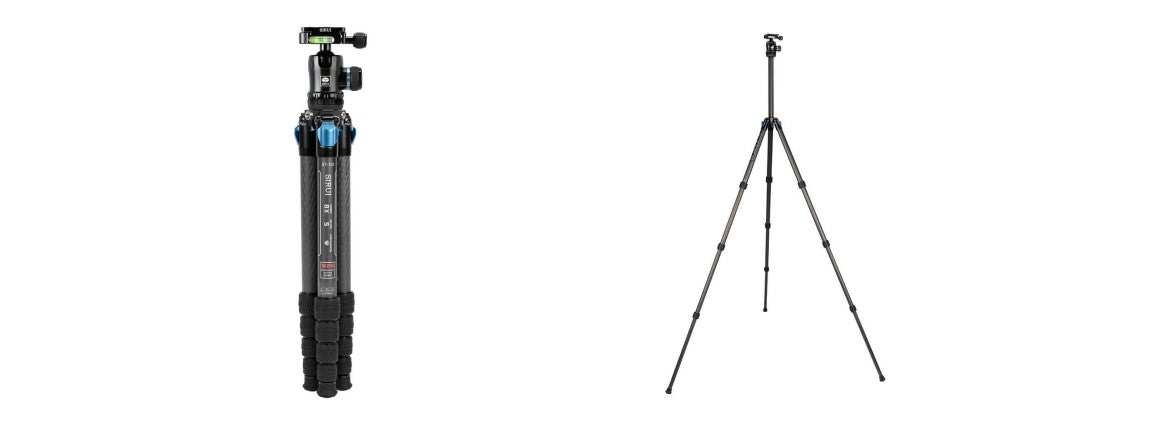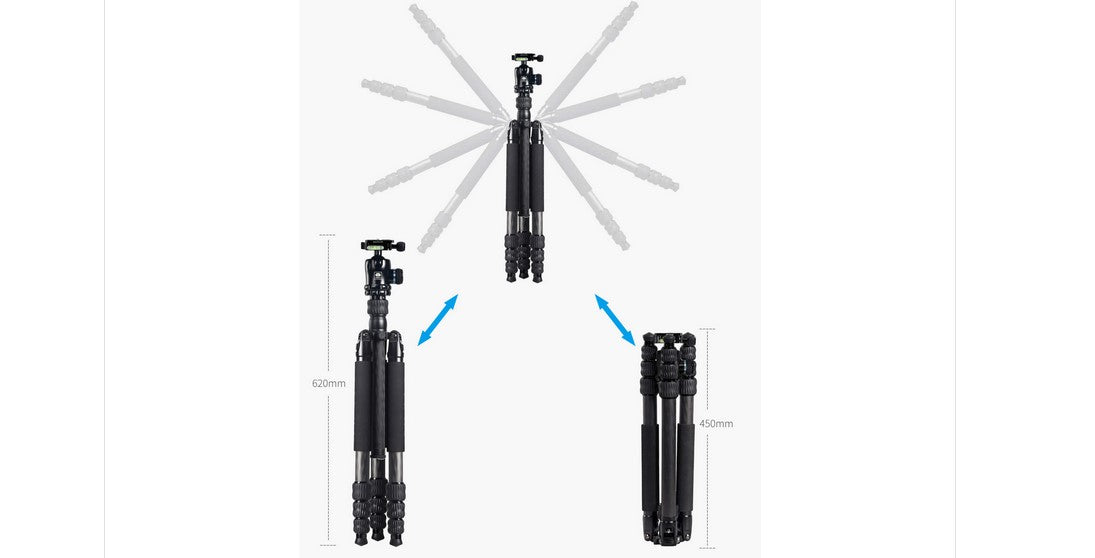Categary
- Material
- Sections& diameter
- Locking mechanism
- Spikes
- Reverse folding design
- Center Column
- Load capacity
- Height
- Ball head
- Material
1.1. Magnesium alloy, aluminum alloy, carbon fiber, etc
1.2 Carbon fiber material is the best, light, good strength, bearing and strong earthquake resistance
Tripods can be divided into the following categories from the material:
High strength plastic: plastic tripod is generally small desktop tripod, the advantage is cheap, light weight, but the durability and bearing is relatively poor.
Iron tripod: very heavy, relatively cheap, but the durability is normal, but with good stability, generally used in the studio or studio environment.
Aluminum magnesium alloy: durability and stability are very good, the disadvantage is heavy weight, poor portability. However, aluminum-magnesium alloy tripod has higher cost performance and is also suitable for indoor or studio use.
Carbon fiber: carbon fiber tripod is very light, excellent stability, high durability, suitable for various environments. It’s the best tripod on the market at present. However their price is generally higher.

- Sectionsand diameter of legs
2.1. The more sections, the smaller the volume after storage
2.2. The fewer sections, the better the stability
2.3. Priority: stability > volume, number of sections ≤4
Tripod can be divided into the following categories from the foot tube size:
The tripod is divided into size 0 (20mm), size 1 (24mm), size 2 (28mm), size 3 (32mm), and size 4 (37mm) in terms of the thickness of the foot tube. In general, the larger the diameter of the foot tube, the greater the load bearing capacity of the tripod and the better the stability. But the tripod is correspondingly heavier.
To be specific, size 0 and size 1 foot frames are suitable for comparison card machines, micro single and relatively light SLR; size 2 foot frame is the mainstream standard, suitable for professional SLR; Size 3 and up are suitable for heavy cameras with telephoto.
Number of foot tube: the number of foot tube of the common tripod on the market can be divided into 3, 4 and 5 sections. In general, the tripod with three legs has the strongest stability, but the portability is poor. The 5-section tripod is the least stable, but more portable when stored.
- Locking mechanism
Tripod foot tube lock is divided into pull button type and knob type, pull button type advantage is to open the speed is fast, adjust the operation is convenient, but the stability is relatively general. Knob locks open slower but more stable. For professional photographers, the general choice of knob lock tripod, after all, to ensure stable shooting is the most important.

- Spikes
Tripod pegs include rubber MATS, which are used on smooth surfaces to avoid scratches and strengthen the grip of the tripod, and metal spikes, which are used on soft surfaces such as soil and mud, suitable for outdoor shooting.
Therefore, buy which kind of nail or see individual demand, indoor and outdoor are patted, had better buy a suit.

- Reverse folding design
Compared to the regular tripod, the folding tripod is shorter and easier to carry, but of course, the operation is more complicated and requires patience.

6. Center Column
A lot of newbies ask that, is it better to have a tripod with a central column or not? In terms of stability, the one without the central column is better.
Because tripods with fewer moving structures are more stable. Some high-end tripods, in pursuit of stability, do not have a central column.
It’s not to say that we need to buy a tripod without a central column, which has its own advantages. For example, if you raise it to the maximum height (the maximum height of the tripod) during a concert, you can take a picture of the scene in front of a dark crowd.
Under normal circumstances, the height index of the tripod includes the maximum height without lifting the central column, the maximum height without lifting the central column and the minimum height without lifting the central column. We should pay attention to the maximum height without lifting the central column.
For rough calculation, the maximum height without lifting the central column = personal height - head height - camera height (distance from bottom to viewfinder) - distance from eyes to overhead.
As a tip, hang heavy objects on the central column in windy conditions to help stabilization.

- Loadcapacity
The load capacity is greater than the total weight of the photography bag + the items in the bag. Under normal circumstances, the weight of the tripod is enough.
- Height
Tripod height depends on your own height, the best equipment on the shelf and the line of sight level
There are two algorithms for tripod height:
- Simple and crude formula: Full height of tripod = personal height -30cm (to 40cm)
- Estimate: Roughly where your chin is
- Ball head
Spherical head: photo or Vlog creation, etc
Hydraulic head: strong load bearing, large weight and volume. Suitable for large equipment
In addition to the above content, also need to consider the height of the tripod, bearing capacity and suitable environment. Tripod height and load bearing are naturally not much, which are related to the use of experience and stability. The applicable environment is whether the tripod can accept the test of special environment, such as shooting in the desert, shooting at the seaside or beside a stream, which requires the tripod to have very good corrosion resistance and wear resistance, which is also one of the contents that the tripod purchase needs to consider.

How to choose tripod and recommendation
Different scenarios determine the choice of tripod. For example, when landscape photographers choose tripods, the first consideration is light portable tripod; The commercial photographers in the studio will choose the most stable tripod products without considering portability.
Second, can I bring it on the plane? Many landscape photographers, often need to take a plane or train to the field shooting, the choice of tripod will consider the length of the tripod after receiving. Because airlines have strict limits on the length of luggage (between 40-55cm), these are also one of the factors to be considered when choosing a tripod. After all, tripods are very strong, but some collisions will also cause damage to them, and carry-on is the best way to travel.
The tripod is then fitted to the device. Choose tripod also should consider according to oneself commonly used photographic equipment. If you use small, lightweight devices like microcameras, portable cameras or cell phones on a daily basis, opt for a small, portable tripod.
If your daily equipment is a professional camera, such as Canon EOS R5 or Nikon Z7 II professional micro single camera, or Canon EOS 5D Mark III, Nikon D850 SLR camera, coupled with a large three-way lens, choose a large tube diameter tripod with good load bearing and stability.
Finally, there's the budget: More than cameras and lenses, tripods are seen as an accessory that can be replaced on the go.
Here is my advice, even if it is small money, we also have to save on saving, the right tripod investment plan should be: account for the whole (camera + lens) 10-15%.
For example, you need to spend at least $500 on a better tripod and head for a $5,000 camera, and $1,000 or more for a $10,000 camera.
Those are some guidelines for buying a tripod. I hope it was helpful.

















Dear, I am currently looking to buy a video tripod. Could you explain the difference between the versus SIRUI SH-25S and the versus SIRUI AM-25S since I cannot find any further info on differences.
Thanks and regards :)
Jurgen